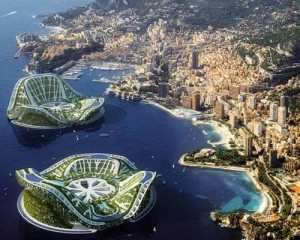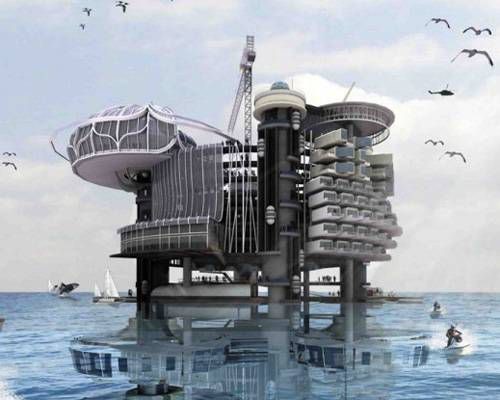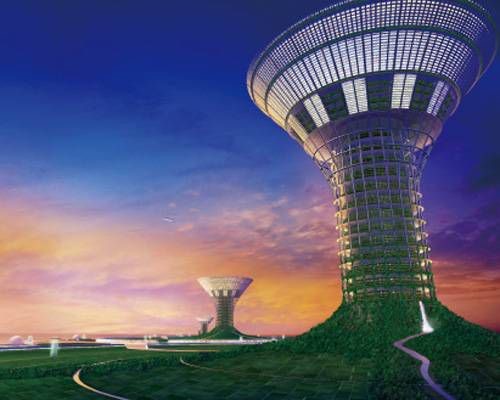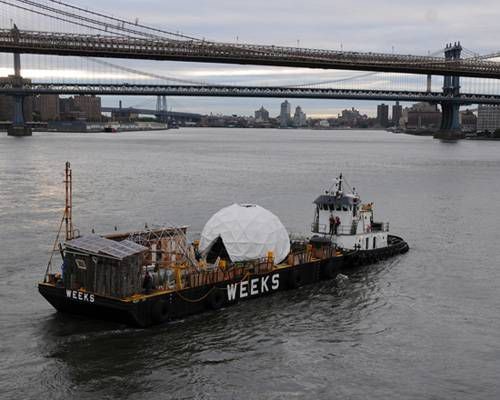Source: mnn.com
Published: April 29, 2011
By: Laura Moss

Photo: Vincent Callebaut Architecture
Real-life ‘Waterworld’
The planet is warming, which is causing glaciers and ice sheets to melt and Earth’s sea levels to rise. As the ocean makes inroads over the next century, people living in low-lying areas will be displaced, leaving them in need of new homes.
Don’t let memories of “Waterworld” deter you from checking out these innovative marine dwellings. Whether you’re concerned that your home will be soon be beachfront property, or you’ve simply always wanted to live life at sea, you don’t want to miss these groundbreaking(water-breaking?) designs.

Photo: eVolo
Water-Scraper
The creators of the Water-Scraper believe that the effects of climate change mean it’s “only a natural progression that we will populate the seas someday,” so they designed this livable, sustainable structure for humans to occupy. The Water-Scraper uses wave, wind and solar power, and its bioluminescent tentacles provide sea fauna a place to live while collecting energy through kinetic movements. This floating structure even generates its own food through farming, aquaculture and hydroponics. A small forest is nestled on the top of the Water-Scraper, along with wind turbines, a garden and livestock, and the living areas are located just below sea level where natural light is best.

Photo: Delft University of Technology
Floating cities
The Dutch are accustomed to building in flood-prone areas so perhaps it’s only natural for them to construct floating cities to cope with climate change. According to design company DeltaSync, such cities would be built to rise along with the sea level. Large blocks of polystyrene foam connected by frames of strong concrete would be used to float the dome-shaped buildings, and these structures would be linked via floating pedestrian bridges. Floating highways would even connect these aquatic cities, and heat drawn from the ocean’s surface would heat the city.

Photo: By Al.geba/Shutterstock.com
Plastic islands
In 1998, Rishi Sowa built his first artificial island using 250,000 plastic bottles to keep it afloat, and today he lives on Spiral Island II, a smaller island that he built using 100,000 plastic bottles. The island features a house, beaches, ponds and even a solar-powered waterfall.
Even more ambitious than Sowa’s island is architect Ramon Knoester’s plan to build Recycled Island, a floating island the size of Hawaii made entirely of plastic from the Great Pacific Ocean Garbage Patch. Aside from being composed of recycled plastic, the island would also be completely self-sufficient, supporting its own agriculture and getting its power from solar and wave energy. When it’s complete, Knoester hopes the island will be home to at least half a million residents who can enjoy the artificial island’s seaweed harvest and compost toile

Photo: Vincent Callebaut Architecture
Lilypad ecopolis
Architect Vincent Callebaut designed Lilypads to be self-sufficient floating cities that can each accommodate up to 50,000 climate change refugees. Inspired by the shape of Victoria water lilies, these eco-cities would be made of polyester fibers and built around a central lagoon, and they would feature three mountains and marinas — dedicated to work, shopping and entertainment. Aquaculture farms and suspended gardens would be located below the water line, and the cities would run completely on renewable energy. Callebaut plans for his Lilypad concept to become a reality in 2100.

Photo: eVolo
Oil rigs
There are thousands of abandoned oil rigs in the Earth’s waters, and Ku Yee Kee and Hor Sue-Wern have proposed that we revitalize these structures and transform them into sustainable housing. A photovoltaic membrane on the roof of the rigs will harvest solar energy, and wind and tidal energy will supplement the solar power. The unique structure utilizes all parts of the rig, allowing people to live both above and below the ocean. The designers plan for the general population to live on the rig itself while marine biologists and other scientists reside and work in underwater labs below.

Photo: Waterstudio.NL and Docklands/Dutch Watervalley
Maldives floating islands
Not one of the 1,200 islands that make up the Maldives is more than 6 feet above sea level, and the island nation is doing everything it can to cope with rising oceans. The country has gone carbon neutral, it’s built retaining walls around every island, and in January the Maldives government signed an agreement with Dutch Docklands to develop five floating islands. The star-shaped, tiered islands will feature beaches, golf courses and an environmentally friendly convention center, and indoor areas will be nestled under green-roof terraces. The project will cost more than $5 million to complete, but it’s a small price to pay when your entire nation is expected to be underwater o

Photo: Shimizu Corporation
Green Float botanical city
Shimizu, a Japanese technology company, designed the Green Float concept to be self-sufficient and carbon-negative, allowing mankind to live harmoniously with nature. Each floating cell district has a radius of .62 miles that can house 10,000 to 50,000 people. Joining these districts would form a city of 100,000, and a group of modules would constitute a country. The towers in the center of each district are structured with residences and hospitals at the periphery, offices and commercial facilities in the center, and plants growing along the tower. Carbon dioxide and wastewater from the urban areas become nutrients for the plants, and grains, livestock and fish live along the base and ocean shallows of the tower. Green Float is powered via solar energy, ocean thermal energy conversion and wind and wave technologies, and such cities would be located along the equator where the climate is stable and not prone to hurricanes.

Photo: waterpod.org
Waterpod
Artist Mary Mattingly envisioned Waterpod as an alternative living model that could be re-created in the future when land and resources are scarce. Built out of recyclables upon a rented barge, the Waterpod runs on solar power, and its crew grows its own food and collects rainwater. Food comes from chickens and gardening, waste is composted, and residents sleep in small quarters built from reclaimed materials. Mattingly and the Waterpod project team say the self-sustaining space might offer a glimpse into the future when mankind lives in mobile aquatic shelters that make up water-based communi

Photo: cesarharada/Flickr
Open_Sailing
The Open_Sailing project is an international community of scientists, engineers, architects and many others who are trying to develop an International Ocean Station. The open-source project aims to create something similar to the International Space Station on the sea, a place where people can study the ocean and learn to live sustainably in a marine environment. The project began as an apocalyptic design response unit, but has evolved into a voluntary community of amateurs, inventors and scientists who study everything from aquaculture to desalination. The creators of this ocean station are working to develop a truly innovative “city” design that will become compact during storms and sail when winds are favorable.
See video Open Sailing – https://youtu.be/o3IS94Z2RZw

Photo: The Seasteading Institute/Vimeo
The Swimming City
András Győrfi’s “The Swimming City” was the winner of the first design contest held in 2009 by The Seasteading Institute, an organization that aims to create permanent, stationary structures where new ideas for government can be tested. Győrfi describes his winning design as a “mixed-use community,” which features a swimming pool, amphitheater, helicopter landing pad and shaded marina.
